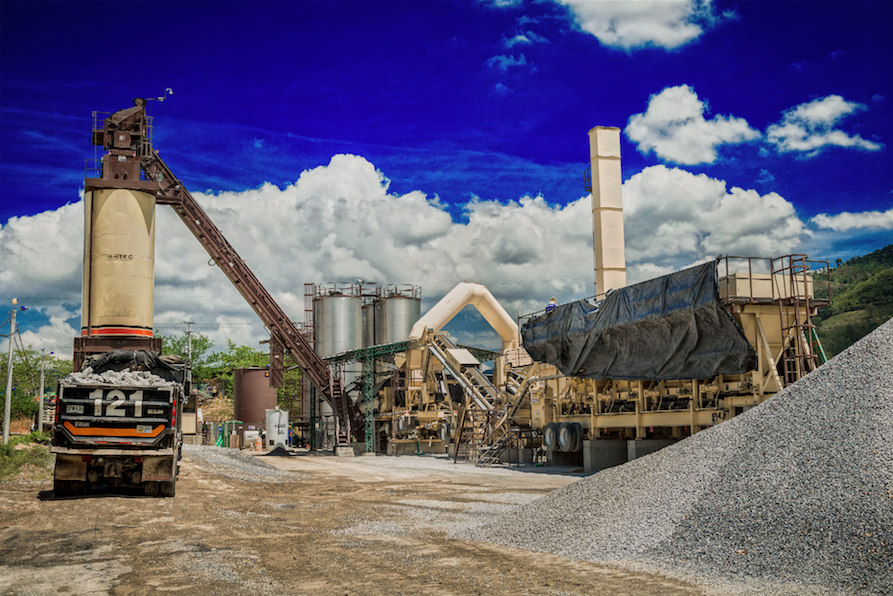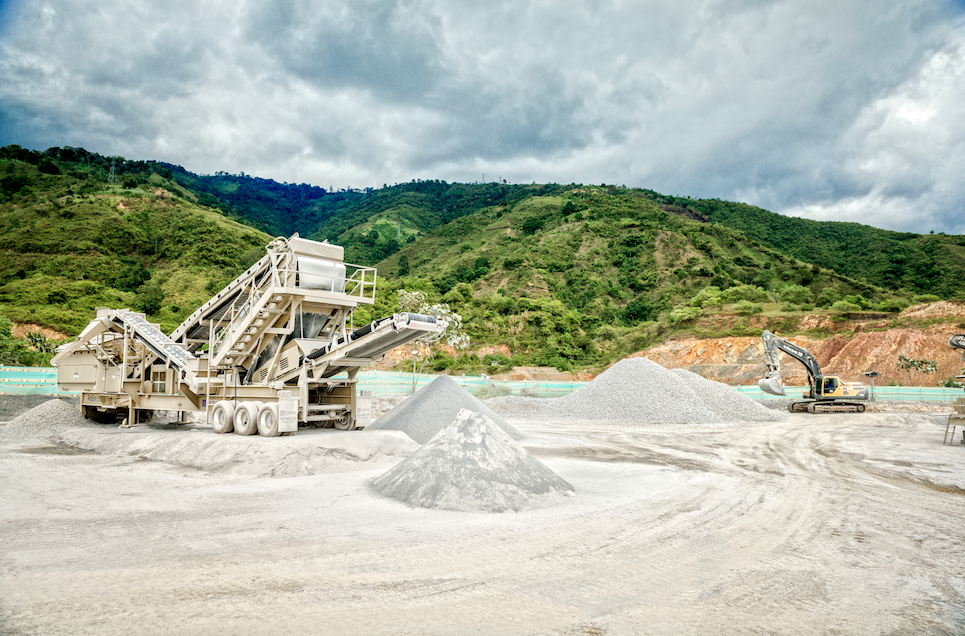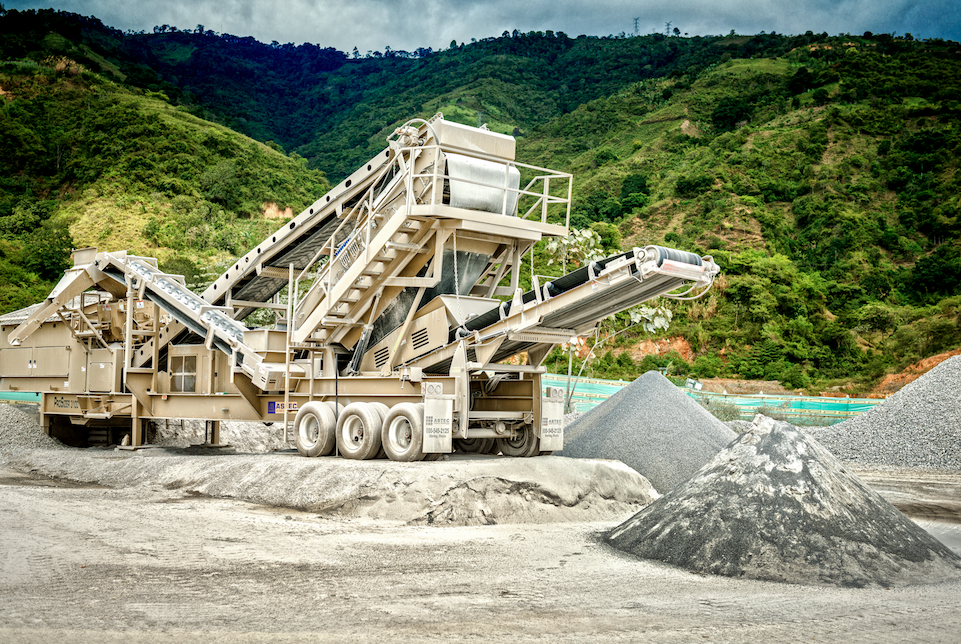MHC Builds Asphalt Highway Through Mountains
BY KPI-JCI, Astec Mobile Screens

When Colombia’s government wished to update its infrastructure, it committed $20 billion toward the effort. The boost in funding was generated by investments from international businesses as well as an increase in GDP spending and represented the largest infrastructure plan in Colombia’s history. The promise of infrastructure funding was good news several years ago for the country’s top contractors, including Mario Huertas Corporation, Bogota, who has been a key player in the development of Colombia’s infrastructure since the 1920s.
Mario Huertas Corporation’s (MHC) roots trace back to 1920, when the company was founded by owner Mario Huertas’ great-uncle. At the time, it worked exclusively in the ports on the Magdalena River, which flows north through the western half of the country. Years later, Huertas’ father started his own company, expanding the family business into other construction and infrastructure-related activities including roads, bridges, viaducts and residential building at the district, state and national level.
For the past four decades, Huertas has been leading the company and works with his son, Esteban, who represents the fourth generation in the family business. With more than 900 employees and $600 million in contracts, MHC is well-established as a progressive pioneer in the industry accustomed to conquering massive civil engineering projects in challenging conditions. The company has earned recognition with the prestigious National Engineering Prize for its work on the Sesquile Dam, and contracts with INVIAS (National Highway Institute).
![Dave McCracken, international sales director for Latin America and the Caribbean for KPI-JCI and Astec Mobile Screens shared the business side of the highway project: “The construction of modern, multi-lane highways in Colombia’s mountainous and rugged terrain is making travel safer and faster for its citizens. On the commercial side, industrial goods for export will be done more efficiently and at a reduced cost as they move to Colombian ports.” The need for infrastructure development and updating in Colombia comes with a commitment to the environment that producers in Colombia share with their colleagues in the North American asphalt industry. “We use any raw material that comes out of this quarry,” Mario Huertas said. “Our materials are being completely used; the materials are clean, combined or reused, but there is no waste, because we have always believed that any material that is obtained or crushed must be placed in the place where it is required, either for making [the mix], fillers, pavement structures, sub-bases or bases.” All photos courtesy KPI-JCI and Astec Mobile Screens, Yankton, South Dakota.](https://theasphaltpro.com/wp-content/uploads/2016/03/4836.png)
Dave McCracken, international sales director for Latin America and the Caribbean for KPI-JCI and Astec Mobile Screens shared the business side of the highway project: “The construction of modern, multi-lane highways in Colombia’s mountainous and rugged terrain is making travel safer and faster for its citizens. On the commercial side, industrial goods for export will be done more efficiently and at a reduced cost as they move to Colombian ports.” The need for infrastructure development and updating in Colombia comes with a commitment to the environment that producers in Colombia share with their colleagues in the North American asphalt industry. “We use any raw material that comes out of this quarry,” Mario Huertas said. “Our materials are being completely used; the materials are clean, combined or reused, but there is no waste, because we have always believed that any material that is obtained or crushed must be placed in the place where it is required, either for making [the mix], fillers, pavement structures, sub-bases or bases.” All photos courtesy KPI-JCI and Astec Mobile Screens, Yankton, South Dakota.
Developing infrastructure in a country riddled with mountains and jungles is no easy feat. One of its recent projects was to construct an 87-mile, four-lane highway across the Andes Mountains between Bucaramanga and Cúcuta. MHC was tasked with the mammoth challenge of designing and building the country’s first four-lane road—as well as all of the bridges and tunnels—located in a mountain range.
“It is a very difficult task given its components, such as colluviums, clay, sandstones and also parts with veins of limestone,” Huertas said. “This combination requires that the work is thoroughly planned, not only in order to use the aggregates but also for the stability of the slopes.”
The new highway is a much-needed channel that now links Colombia to Venezuela. The project’s difficulty was found not only in getting usable material in a close proximity to build the road, but also in overcoming the country’s demanding topography. The former road between Bucaramanga and Cúcuta was narrow and steep, with altitudes ranging from 900 meters above sea level up to 3,600 meters. The new highway’s design levels out the road to a maximum 7.5 percent incline—down from a high of 18 percent. Now vehicles can travel as fast as 50 miles per hour, reducing travel time from Bucaramanga to Cúcuta from six hours to two and a half hours.

Huertas purchased three GT165DF screen plants to clean the raw material, as well as two FT4240CC impact crushers, a 2500 vertical shaft impactor, ProSizer and a PTSC 2618 high frequency screen to make aggregate for asphalt mixes.
All of this had to be accomplished without interrupting the flow of traffic of vehicles traveling from Bucaramanga to Cúcuta, and, at the same time, maintaining the integrity of the natural landscape.
“Our work has been exemplary both from an environmental point of view and regarding the handling of the resources of a public works project,” Huertas said. “The entire responsibility falls to us to take care of the fauna and flora of these mountains, and we must recover many areas with native species. Therefore, it is a much more comprehensive construction than older projects or other projects in Colombia.”
The end result is a country that will have an updated infrastructure capable of meeting Colombia’s growing needs for travel and trade, according to Dave McCracken, international sales director for Latin America and the Caribbean for KPI-JCI and Astec Mobile Screens.
“The construction of modern, multi-lane highways in Colombia’s mountainous and rugged terrain is making travel safer and faster for its citizens,” McCracken said. “On the commercial side, industrial goods for export will be done more efficiently and at a reduced cost as they move to Colombian ports.”
The complexity of the project required MHC to invest in high-quality mobile equipment that could classify aggregate without the use of water—which is limited in the region—as well as provide a high production rate, according to Huertas. But most importantly, he was seeking a relationship with a manufacturer and local dealer.
“Throughout this process, we expected to be guided and advised by the dealer and the manufacturer in terms of making improvements or adapting the machinery to our environment, which is different in each country, given the operation, geography and site location,” Huertas said. “KPI-JCI and Astec Mobile Screens, as well as Astec, Inc., provided me with research and the opportunity to observe the equipment working in other countries, so as to unify criteria and optimize resources.”
Through KPI-JCI and Astec Mobile Screens authorized dealer Rodríguez y Loñdono and Fernando Marroquin, international regional manager for Astec Aggregate and Mining Group, Huertas purchased three GT165DF screen plants to clean the raw material, as well as two FT4240CC impact crushers, a 2500 vertical shaft impactor, ProSizer and a PTSC 2618 high frequency screen to make asphalt aggregate. MHC also invested in a new Astec Double Barrel® Green warm mix asphalt system.
One of the major challenges of the project was obtaining the land to house the asphalt plant and aggregate processing equipment, Huertas said. The company ultimately selected a limestone quarry at Surata near Bucaramanga, which reduced travel and allowed all of the crushing and screening equipment to be located in the same place. Unlike many other quarries, every piece of material is used, eliminating waste from the company’s operation.
“We use any raw material that comes out of this quarry,” Huertas said. “Our materials are being completely used; the materials are clean, combined or reused, but there is no waste, because we have always believed that any material that is obtained or crushed must be placed in the place where it is required, either for making [the mix], fillers, pavement structures, sub-bases or bases.”

To make the most of crushing tonnage, the crew classified the raw aggregates and removed the fines on the screens prior to crushing. “This feature has greatly helped us be more effective and arrive at a much more real crushing tonnage, thus preventing the fines from wearing out parts or components of the machines used.”—Mario Huertas
According to Huertas, the success of the asphalt plant is directly linked to the success of the crushing and screening of the aggregate, making the selection of quality equipment prior to the start of the job one of the most crucial steps in the process.
“The GT165DF track-mounted screens make it possible to classify the raw aggregates and remove the fines, which can affect the crushing of the aggregates,” Huertas said. “This feature has greatly helped us be more effective and arrive at a much more real crushing tonnage, thus preventing the fines from wearing out parts or components of the machines used.”
Another key factor in partnering with KPI-JCI and Astec Mobile Screens was the mobility of the track-mounted equipment. According to Huertas, the equipment’s portability provided versatility and efficiency to the project.
“Because the equipment is mounted on tracks, we were able to rapidly transport these machines during the processing of aggregates,” he said. “We could bring the machines directly to the aggregate deposits where the raw materials are being obtained so we could classify them, which saved us time and money.”
